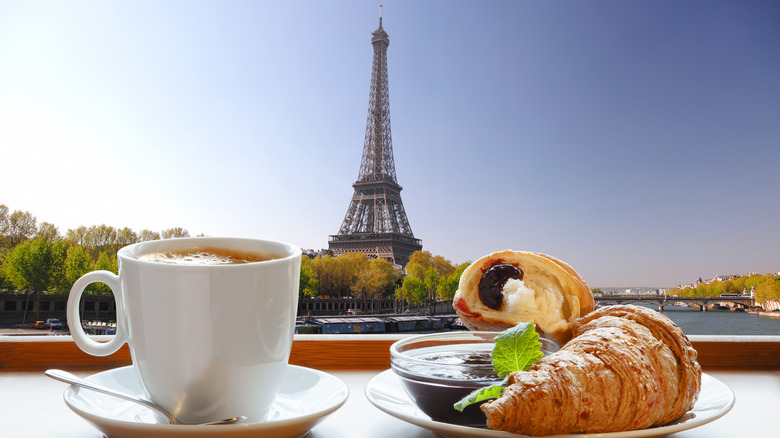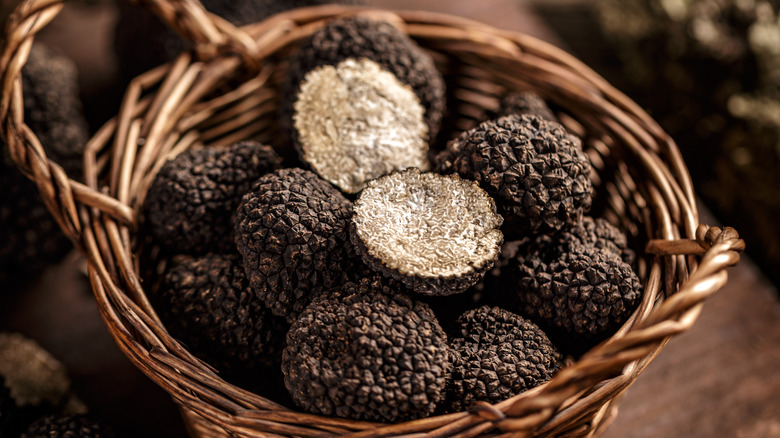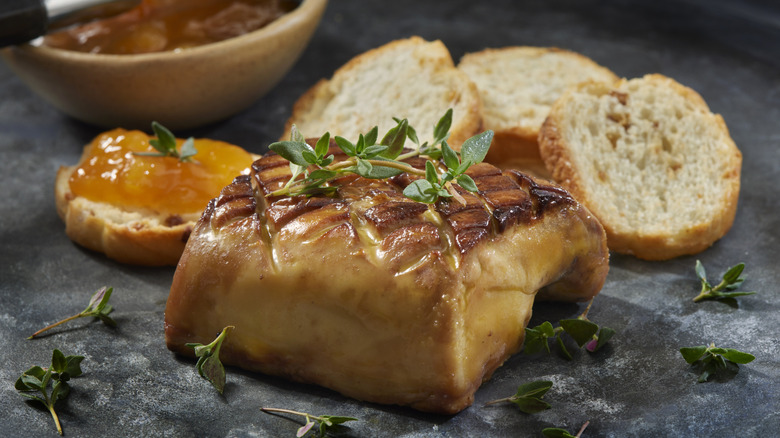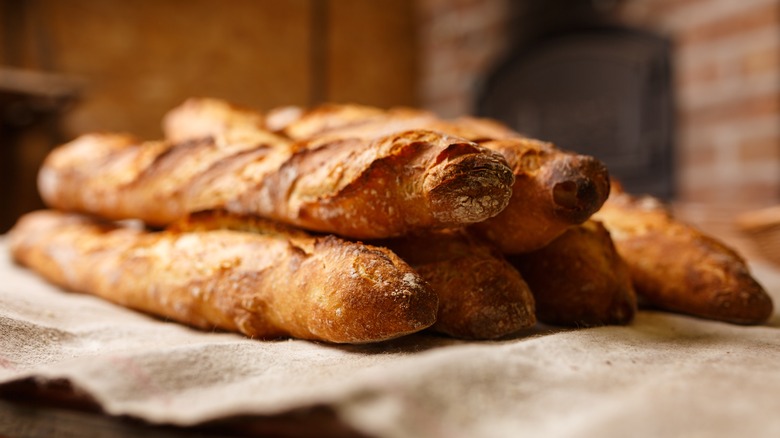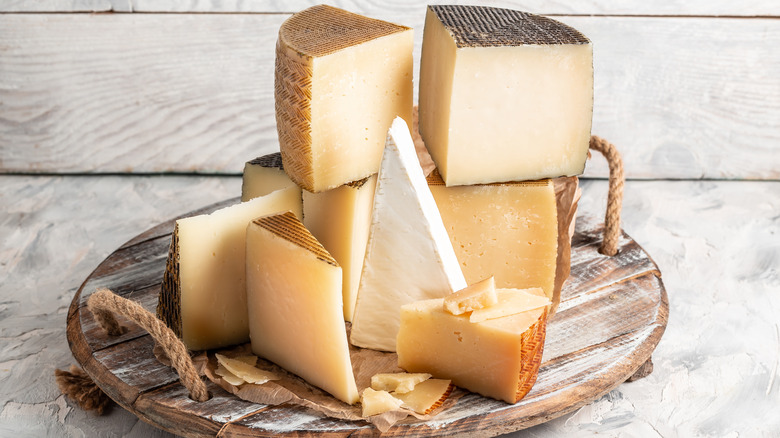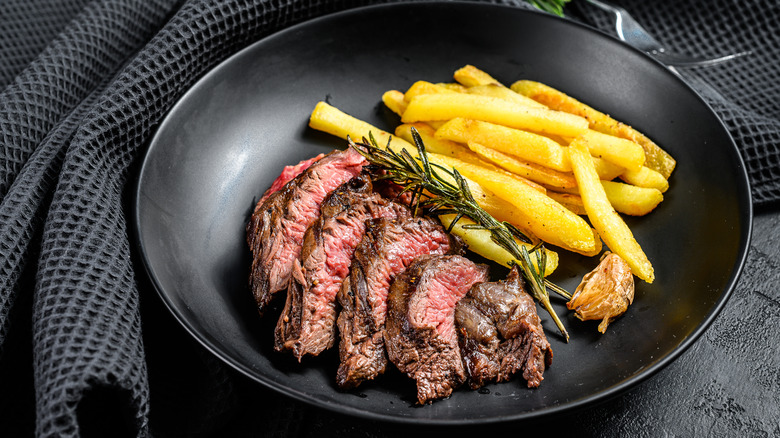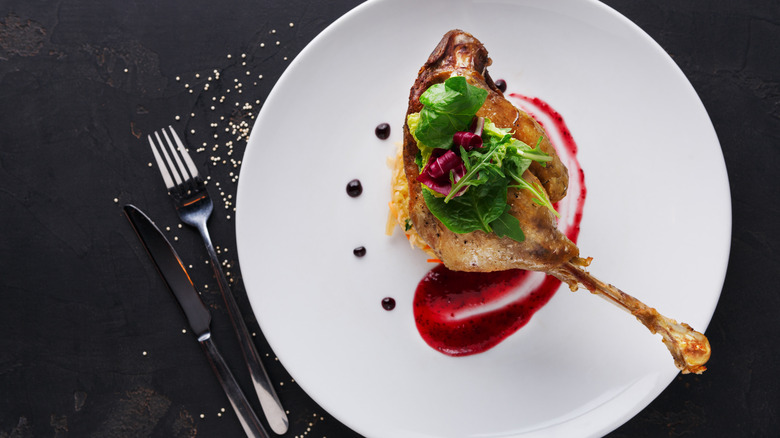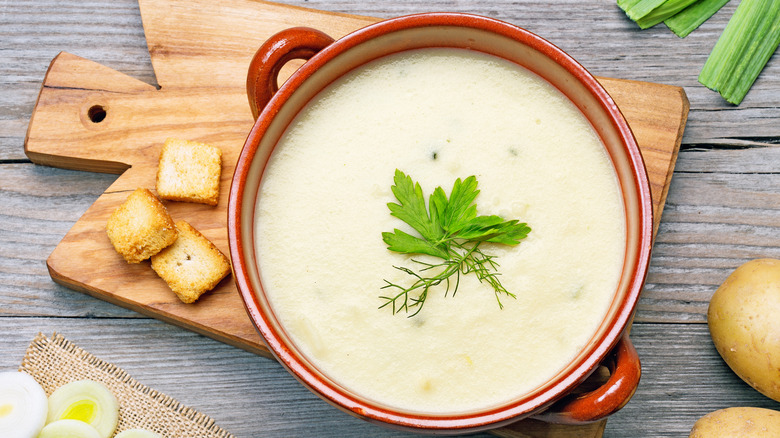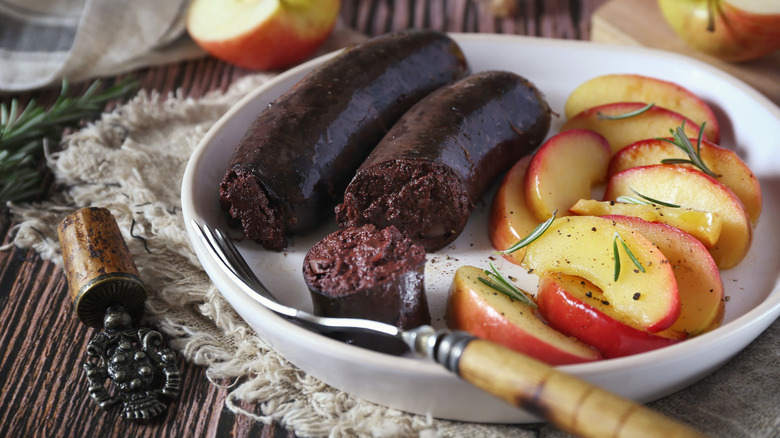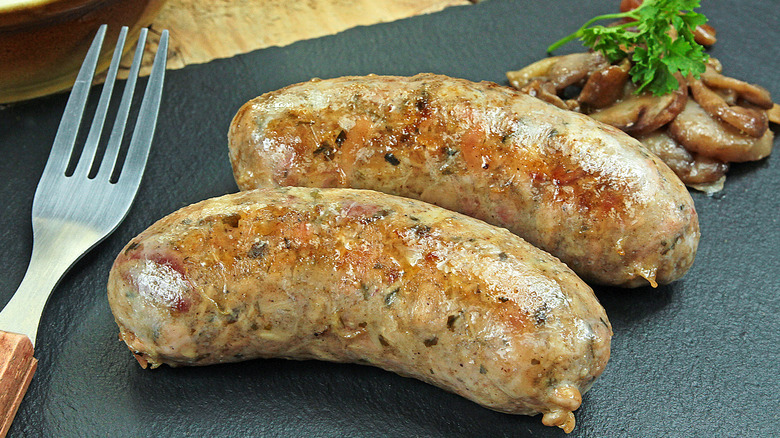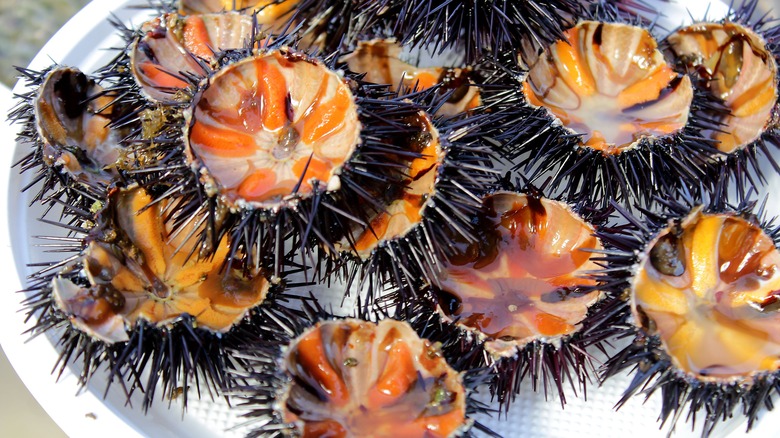11 Traditional French Dishes And How To Spot The Fake Versions
True French dishes are inspiring and oftentimes deliciously deceptive in their simplicity. French cuisine is about using beautiful ingredients like French butter with seasonal proteins and produce and combining them to create decadent dishes. Even the most basic dishes like a croissant or a jambon beurre (a smear of fresh butter on bread topped with French ham) can transport your taste buds to an idyllic sidewalk cafe with a view of the Eiffel Tower.
However, it is those stereotypical ideals that also allow the unwary to fall for fake versions of those beautiful French dishes, including truffle-laced entrées, steak frites, and boudin noir. Unsuspecting tourists walking the streets of Paris may not realize the high-priced menus with long lists of French classics are variations made in-house.
You don't have to study French cuisine or be a master chef to know what makes a baguette truly French bread with a little help from us! Some French dishes you find are even made better by eating the faux versions, as understanding those differences lets you be informed.
Truffles
While truffles alone are not a complete dish, they are one of the most prized, expensive, and mislabeled items in many dishes. You may have picked up a bottle of truffle oil, seen truffle-flavored chips at your local grocery store, or had truffle fries. Sadly, most of these are artificially created flavorings.
In the world of truffles, there are a few varieties. While black truffles are the most commonly known variety, the most expensive is the white truffle, which averages $260 for 1 ounce (at the time of this article). That's pretty steep! What makes them so valuable? It's all about rarity. The different varieties of truffles have limited seasons and are difficult to find. Truffle hunters use highly trained dogs or pigs to seek out truffles. Not only are they tough to find, but you must carefully dig them up and, once exposed, truffles only have a five-day shelf life. All these components add up to a rare delicacy.
So, how do you spot a fake? At a restaurant, this is tricky but possible. If the price seems too good to be true (as in, cheap), you're most likely looking at a fake. When buying truffles, there are also imposters called Bohemian truffles. Truffle oil is the easiest substitute to decipher. True truffle oil is olive oil infused with large pieces of truffle, has a unique truffle smell, and contains no chemicals. Use for finishing — you'll kill the truffle flavor if you use it for cooking!
Foie Gras
Served as a mousse, as a pâté, or whole, foie gras ("fat liver") is delicacy because of its fatty, rich, and creamy texture but has come under condemnation by animal rights activists, celebrity chefs such as Wolfgang Puck, and governments both in and outside of France. Foie gras is created in a process called gavage, or "force feeding," which enlarges the bird's livers 10 times larger than natural.
Given this, a faux gras isn't actually a bad thing. You might want to try a vegetarian version for yourself! You can substitute tofu for a creamy texture. We won't say it makes faux gras healthy, but it's tasty, and that's all that matters!
While you can make your own "faux" gras or buy vegetarian or chicken options at a restaurant, how do you know if you're purchasing fake or good-quality foie gras? Quality jarred or canned comes in two options: duck or goose foie gras. Duck foie gras should have a rustic aroma whereas goose foie gras is more refined. Goose should have a subtle taste and be rosy, firm, and smooth on the palate.
The easiest way to know if your foie gras is good quality is look at the country of origin. While a French version is best, there are other possible choices. The less intermediaries, the better. There are also ratings you can look for; the best options will say" Périgord geese" or "foie gras duck from the South West."
Champagne
There is little more iconic than golden Champagne bubbling in tall glass flutes. While this celebratory beverage is immediately recognizable, you may not actually be looking at real Champagne. There are many misconceptions and falsehoods surrounding this sparkling wine. One of the major issues is how your sparkling wine is served. A skinny flute restrains the aroma, thus also inhibiting the flavor. While using a flute doesn't mean you're drinking a fake, you won't be getting the full experience of your wine's flavor.
Pinot Noir, Chardonnay, and Meunier are the three main types of Champagne, and saying "champagne" is where the biggest misconception occurs. The label is often used to denote any golden sparkling wine, but a true Champagne can only be labeled as such if the grapes are AOC grapes. Anything else is just sparkling wine. One indicator is that capital "C" denotes real Champagne and not sparkling wine — check the bottle's label.
An authentic bottle of Champagne will have a Professional Registration Code and other details regarding the production. This is important as only about 400 towns in France are authorized to use the name "Champagne." While you can get quality sparkling wines from other regions such as California, Spain (cava), or Italy (prosecco), only those bottles of sparkly wine produced in the Champagne region of France are authentic.
French bread
There is something magical about seeing a long, crusty loaf of French bread. Images come to mind of beautiful women with scarves around their neck and giant sunglasses pedaling bikes with a basket on the front, the obligatory baguette sticking out and immediately transport us to a romantic, Parisian café. While these images are cliché, there is nothing as delectable as an authentic French baguette.
The loaf of French bread is iconic because, like so many other French baked goods, the baguette is unparalleled. An authentic baguette is both simple and complex. The loaves are complicated because according to French law, the bread can only be made using four main ingredients: wheat flour, yeast, salt, and water. While these are basic ingredients, chefs must high-quality ingredients, and the specialized techniques make this simple recipe complex.
If you're in France, one of the easiest ways to tell if a bakery abides by French bread law ("Le Décret Pain") is to look for a sign designating "Votre Boulanger. Un artisan authentique" ("Your Baker. An authentic craftsman"). Breads such as eggy brioches, flakey croissants, and tangy sourdough Pain de Campagne do not adhere to the law. If you are buying a true French loaf, the crust should crackle when lightly pressed and be dark golden brown. If you tap the underside, it should sound hollow.
French cheeses
No charcuterie board would be complete without at least a creamy Camembert or brie. French cheese makes the perfect accompaniment as part of an appetizer, as an entree in fondue or as an after-dinner cheese plate. But what is about French cheeses that makes them so delectable?
In the world of French cheese, there are three families: blue, pressed, and soft. Within these families there are classifications such as the type of milk used and the origin of the cheese. All of these distinctions are part of the very serious business of being labeled a true French cheese. The French take wine, lavender, and cheese extremely seriously. In the case of all three items, there is a government agency which controls the labeling.
For a cheese to be considered "French," it must have the designation Appellation d'Origine Contrôlée (AOC), meaning "controlled designation of origin." Over 40 different cheeses are designated as AOC, so check the labels. Other countries also have designating labels and controls, such as the Common Agricultural Policy of the European Union, for several French cheeses. These two labels help ensure your cheese is of the utmost quality.
However, not all fake French cheeses are bad! For dairy-free folks, there are some tasty tasty vegan options. Using a blend including ingredients like coconut and sunflower oils with cashew milk creates creamy, spreadable cheeses. While these blends are not AOC approved, they are vegan and tastebud approved!
Steak frites
Steak frites seem simple because there are only three items, but that's what makes them a classic French dish. When the best-quality ingredients are cooked well, steak, potatoes, and butter become an almost religious experience. Steak frites, or "steak fries," are exactly that — steak with fries. The three elements can vary based on what cuts of beef are used, the thickness of the fries, and the type of sauce served. The more traditional cuts are rib eye, flat iron, or filet mignon. The steak can be grilled, but the traditional method is pan searing.
What differentiates American steak fries and French steak frites are the fries, but there are no hard and fast rules. In the American steak and fries, thicker steak fries accompany the steak. The classically French frite is a thinner cut and double fried. A golden, crispy fry is key no matter how the fries are cut.
The final element is the sauce, which is what makes a true steak frite. Traditional steak frites are served with one of two French sauces. Au poivre, essentially black peppercorns with beautifully browned butter, is the go-to sauce because it brings the flavor of the steak out. The second sauce is Bearnaise. The touch of tarragon and vinegar is amazing on crispy frites. If you're served other sauces like gravy or aioli, you've not been duped. Unlike French bread, cheese, or wine, steak frites are open to interpretation, so try them for yourself!
Confit de Canard
Confit de Canard (duck confit) is considered a delicacy because of the time and effort it takes to create the dish. Confit de Canard historically was cooked using whole ducks, but more current variations use just the legs and thighs. You may also see duck breasts in some dishes. The meat is first preserved (translated in French to "confit") with salt-curing then chilled overnight. marinated before cooking on a low temperature. The duck is then cooked in more duck fat low and slow. These time and effort consuming methods result in a decadent, rich dish.
Before refrigeration was available, confit de canard was a method to preserve the meat. Since the duck was preserved in salt and fat the dish didn't have to be kept chilled. The fat creates a barrier against bacteria and can last for several weeks if kept in a cool room. We don't advise this though!
Traditional recipes can sometimes take dozens or more steps over a few days. Since most of us don't have or want to take days, and have access to refrigerators, chefs like David Lebovitz in his book "My Paris Kitchen," have taken steps to "hack" Confit de Canard. Some recipes shorten the overall process, eliminate steps, or substitute duck fat. These changes don't make the duck any less delicious, but it does mean even us home chefs can make our own delectable duck dish.
Vichyssoise
Vichyssoise (pronounced vi·shee·swaaz) — fun to say and even more fun to eat. For many people, this cold, creamy, potato-and-leek soup was made famous by Julia Child. The chilled soup actually has a long, oft debated history. Chef Louis Diat is credited as the creator of Vichyssoise, but warm potato, cream, and leek soup has long been a culinary staple of French housewives. A recipe for potage à la Parmentier, a similar dish, was found in a 19th century cookbook.
While the history of vichyssoise is unclear, the keys to a great recipe are. There is no "correct" or "only" recipe, but the basics always involve cooking potatoes, leeks, and cream until softened and blending until smooth before chilling. The only "rule" is that vichyssoise is chilled. If served warm, it is a Parmentier, or "potato soup," but that's tasty, too!
Where the traditional recipe stops, customization starts! If we use Diat's recipe as the comme il faut ("proper") one, he says only the white parts of the leeks should be used, but other chefs disagree. Diat's recipe also uses light cream and milk, but chicken or vegetable stock is used in other variations. You may see onion, white wine, or celery in some recipes. The choice is yours!
Boudin noir
Boudin noir is a French staple and is considered one of France's most traditional sausages. Boudin noir, also known as black pudding, black sausage, or, in Spanish, morcilla, has many variations throughout Europe. Blood sausages variations in Ireland and the U.K. add oatmeal, bread crumbs, or barley along with onions, tomatoes, and a host of seasonings. In these two regions, the sausages are also called blood or black pudding.
Babineaux's Slaughter House in Louisiana describes the flavor and texture of boudin noir as "Hearty, dense, complex, and earthy." French boudin noir is made from pork, pork blood, onions, and apples. Apples are often used in the sausage and served alongside. The recipes and flavor profiles of the sausage will be different depending on region and producer, but there is no true, singular recipe.
Because boudin noir is made with blood, people in the U.S. may think it is illegal. This is partially correct. The production of blood sausage was illegal to produce for a time due to the use of fresh pig's blood. The USDA now stipulates that sausage can be made from hogs that were inspected and freshly killed. If you've not heard of or seen boudin noir, or other similar variations like red boudin and blanc boudin, you're not alone.
Andouillettes de Troyes
Andouillette, a traditional French sausage produced in the Champagne Ardenne region of France, is almost more of a dare than a dish for some people. This is not to be confused with the American andouille sausage popular in the Southern United States, as the two sausages are vastly different. Andouillette is a sausage made from lengthwise cut chitterlings seasoned with onions, spices, salt, and pepper then stuffed into pork intestine and simmered for hours. According to some, the sausage "smells and tastes as if it should be in a lavatory" (via The Telegraph).
Not everyone thinks Andouillette is distasteful, though. Various accounts say that at one point, the Royal Army was supposed to be fighting the Champagne army. Instead, the "delicious" aroma of butchers cooking andouillette de Troyes sidetracked the soldiers and they gorged themselves on sausages instead. There's even a club that judges and regulates andouillette, the Association Amicale des Amateurs d'Andouillette Authentique (Friendly Association of Authentic Andouillette Lovers). Each year, the AAAAA rates andouillette at a biannual event hosted by the Parisian charcuterie school CEPROC, giving success sausages a 5A status.
A true andouillette is difficult to produce and can bring a high price in restaurants. Because there are not many butchers who produce this unusual sausage, it is considered a delicacy. There is the temptation to make fraudulent versions, which the AAAAA does address. If you're interested in trying andouillettes de Troyes in France, look for the AAAAA's 5A rating at a restaurant.
Oursins (Sea Urchins)
Oursin, sea urchin, or in Japanese cuisine, uni, is a rare delicacy no matter where you get it. In France, the spiny little sea creatures with the orange roe are delectable bites you can eat raw and can attend various festivals in dedication to along the coast. In mid-March, you can attend the Les Oursinades festival in Sète, where they have special events and tastings. You can even catch and eat your own urchins during this event.
Provence holds their Blue Coast Seafood Festival where scuba divers scoop adult urchins during permitted dates between November 1 and April 15. Limited permits are available if you want to try collecting your own uni. During the off season in Provence, you may see vendors or restaurants advertising "Blue Coast sea urchins." These are either mislabeled or have been caught illegally. The summer is considered sea urchin's reproduction season and it is thus illegal to catch them.
You can eat oursins raw, right out of their shells, or cook the roe in a variety of ways. If your oursin is served in its shell but is detached, you might have a fake. The colors of urchin should be bright yellow, gold, or orange (the most common), and they should taste creamy.
According to Animals Around the Globe, oursins are considered a threatened sea creature. If you would rather not eat a threatened creature but still want the taste of a sea urchin, you can grow your own at home!

